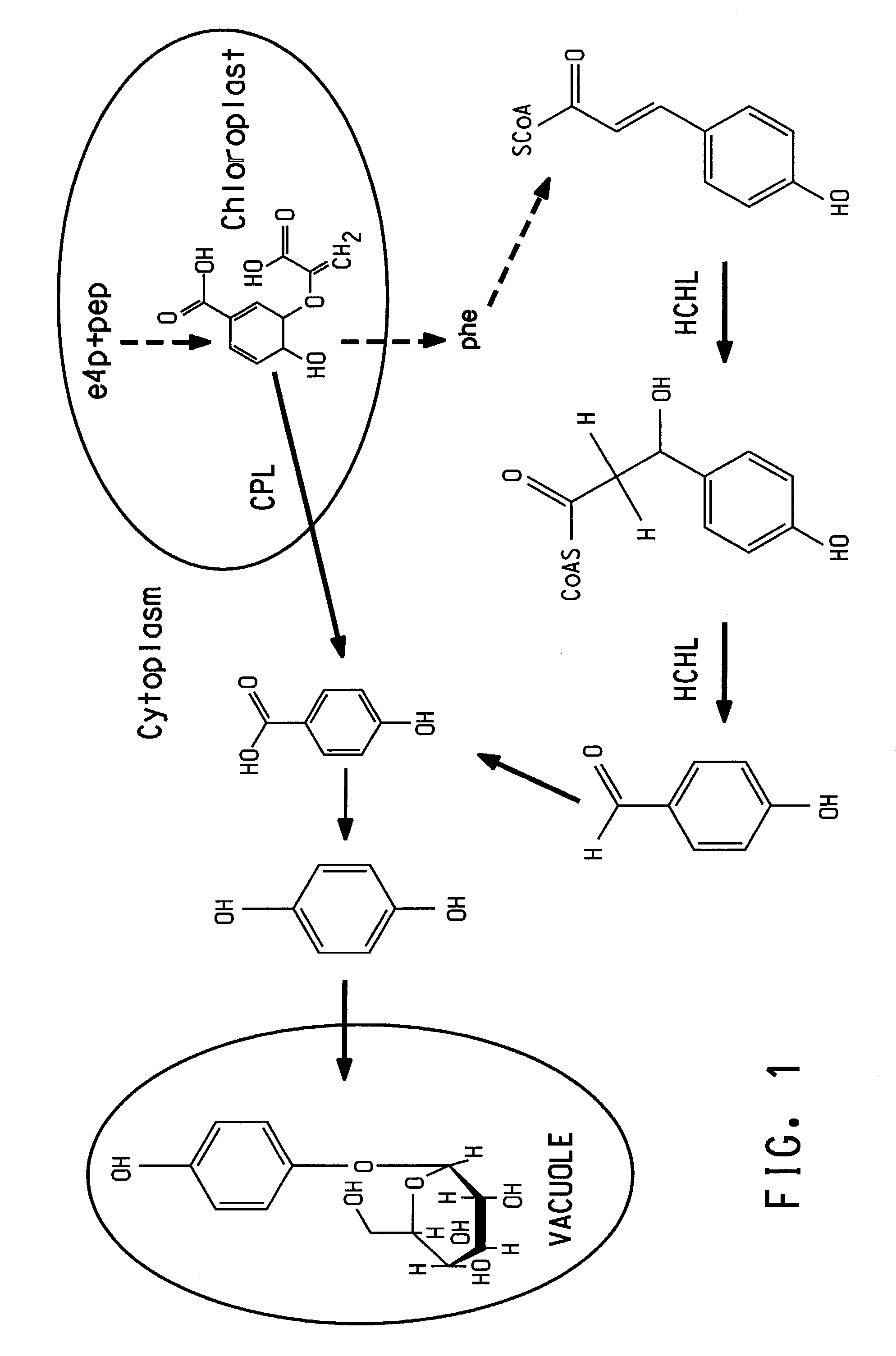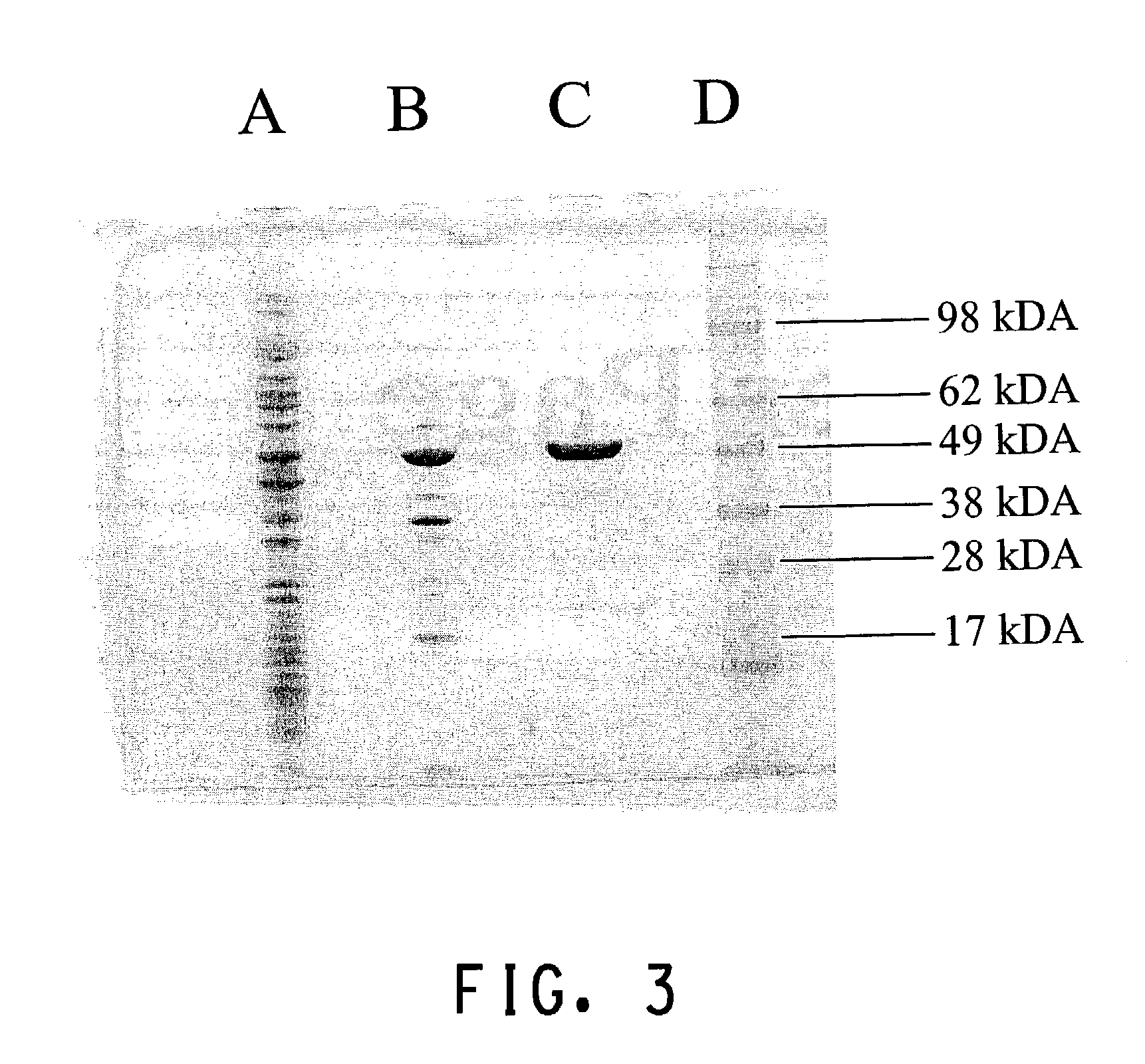High Level production of arbutin in green plants
a production level and arbutin technology, applied in the field of plant gene expression, molecular biology, microbiology, can solve the problems of cytotoxic melanocytes, irritating and irritating melanocytes, and reducing the production of arbutin, so as to increase the production of phba and maximize the effect of phba production
- Summary
- Abstract
- Description
- Claims
- Application Information
AI Technical Summary
Benefits of technology
Problems solved by technology
Method used
Image
Examples
example 1
Growth of Candida parapsilosis ATCC 7336 and Analysis of pHBA 1-Hydroxylase Activity
[0180]A yeast culture was established on YM media plates (formulated per liter; 3 g yeast extract, 3 g malt extract, 5 g peptone, 10 g glucose, and 15 g agar) from the lyophilized ATCC culture stock. The yeast cells were grown at 30° C. under aseptic conditions in liquid media or on agar plates containing double concentrated Reader's medium (formulated per liter; 3 g (NH4)2SO4, 1.4 g MgSO4.7H2O, 1 g NaCl, 0.4 g CaCl2.2H2O, 2 g KH2PO4, 0.2 g K2HPO4, 0.4 mg H3BO3, 0.4 mg MnCl2, 0.4 mg Na2MoO4, 0.4 mg ZnSO4, 0.2 mg KI, 0.2 mg CoCl2, 0.08 mg CuSO4, 0.1 mg FeCl3, 0.4 mg panthothenate, 0.4 mg nicotinic acid, 0.4 mg pyridoxine, 0.4 mg para-aminobenzoic acid, 0.8 mg inositol, and 0.0025 mg biotin). The carbon source was 100 mM glucose or 1 mM, 10 mM, or 100 mM pHBA. Applicant determined that Candida parapsilosis (ATCC 7336) was able to grow on pHBA as the sole carbon source. Best growth on solidified media w...
example 2
Purification of the pHBA 1-hydroxylase Enzyme, Determination of Partial Amino Acid Sequence of the Purified Protein, and Cloning and Sequencing of a cDNA Encoding the pHBA 1-hydroxylase Protein
[0184]Two 5 L flasks, each containing 1 L of double-concentrated Reader's medium (Karasevich and Ivoilov, Mikrobiologiya, 46(5):846–56 (1977)) containing 1 mM of pHBA, were inoculated with colonies of Candida parapsilosis (ATCC 7336) grown on plates with 10 mM pHBA as the sole carbon source. Each culture received successive additions of 100, 300, and 600 mL of double concentrated Reader's medium containing 50 mM of pHBA at 24 h intervals. Cells were harvested 24 h after the last addition of pHBA. Thus, 4 L of yeast culture were grown under conditions where the pHBA concentration was gradually increased from 1 mM to a final concentration of 26 mM during the 96 h time interval.
[0185]Cells were harvested by centrifugation (5000×g 10 min) and resuspended in 35 mL of 20 mM Tris / H2SO4 (pH 7.8), 0.5 ...
example 3
Expression of the pHBA 1-hydroxylase Gene in E. coli and Biochemical Characterization of the Recombinantly Produced pHBA 1-hydroxylase Enzyme
[0214]This work was initiated before the unambiguous sequence of the pHBA 1-hydroxylase transcript (SEQ ID NO:21) was known. Complementary DNA (cDNA) was generated using 5 μg of total RNA isolated from Candida parapsilosis (ATCC 7336) cultures grown in the presence of pHBA as the sole carbon source using the first strand cDNA synthesis kit from MBI Fermentas according to the instructions of the manufacturer. A new primer (Primer 9) was synthesized.
[0215]
Primer 9 - (SEQ ID NO:24)5′-CCCGCACATaagcttAGCCTGATGCACTTAATGG-3′
The underlined nucleotides of Primer 9 anneal at the 3′ end of the pHBA 1-hydroxylase. Nucleotides in small caps introduce a HindIII restriction site immediately following the stop codon.
[0216]A PCR reaction mixture (100 μL) containing 2.5 mM MgCl2, 2 mM dNTPs, 10 mM Tris / HCl (pH 8.8), 50 mM KCl, 0.08% Nonidet P40, 1 μM of Primer 1...
PUM
| Property | Measurement | Unit |
|---|---|---|
| Fraction | aaaaa | aaaaa |
| Electrical conductance | aaaaa | aaaaa |
| Fraction | aaaaa | aaaaa |
Abstract
Description
Claims
Application Information
 Login to View More
Login to View More - R&D
- Intellectual Property
- Life Sciences
- Materials
- Tech Scout
- Unparalleled Data Quality
- Higher Quality Content
- 60% Fewer Hallucinations
Browse by: Latest US Patents, China's latest patents, Technical Efficacy Thesaurus, Application Domain, Technology Topic, Popular Technical Reports.
© 2025 PatSnap. All rights reserved.Legal|Privacy policy|Modern Slavery Act Transparency Statement|Sitemap|About US| Contact US: help@patsnap.com



